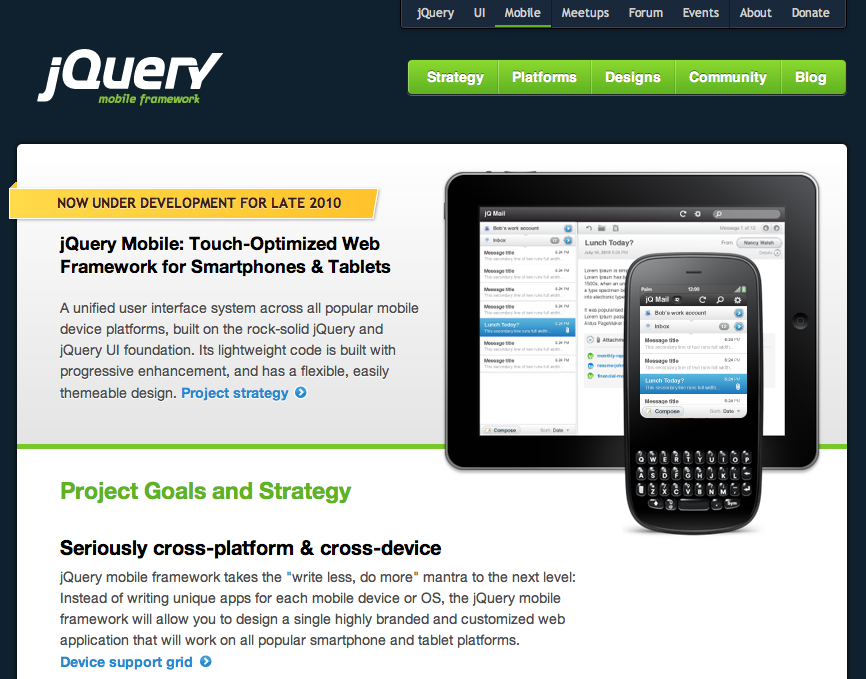By: Michał Gołębiowski-Owczarek, Felix Nagel, and the jQuery team
Editor’s Note: the following blog post was originally published to the OpenJS Foundation Blog.
jQuery maintainers are continuing to modernize its overall project that still is one of the most widely deployed JavaScript libraries today. The team announced that the cross-platform jQuery Mobile project under its umbrella will be fully deprecated as of October 7, 2021. New technologies for mobile app development have evolved since this project was launched in 2010, so we’re encouraging developers to plan for this jQuery Mobile transition.
Please note that:
- The Download Builder will remain available.
- Mobile 1.4 is not compatible with the latest jQuery Core.
- Issues will be turned off. Please report critical security bugs via email to security@jquery.com.
Celebrating jQuery Mobile’s History
jQuery Mobile was conceived and announced in 2010, three years after the launch of jQuery. The project was exciting and ambitious. At announcement, jQuery Mobile promised compatibility across multiple platforms, browsers, and versions. Several mobile browser vendors, including Palm and Mozilla, signed on to sponsor the project:
“The jQuery community has focused on making the Web as productive and fun as possible. When we heard the mission behind jQuery Mobile, we wanted to help. With webOS we have shown that the Web platform is fantastic for developers, so we are excited to help make jQuery Mobile as good as it can be.” -Dion Almaer – Palm
At the time, the mobile web was desperately in need of a framework capable of working across all browsers, allowing developers to build truly mobile web applications. jQuery had already changed the way developers were building on the web, making it easier (and faster) to create secure, compliant applications.
With jQuery Mobile, the project’s goals were to bring the ease-of-use of jQuery to HTML-capable mobile device browsers and to make it easier for developers to build progressively enhanced web applications. Led by Todd Parker of Filament Group, a development studio known for their work on cross platform and accessibility-first applications, jQuery Mobile launched its alpha release in October 2010.
Alpha features included several components, layouts and theming tools that simplified the process of building a mobile web application. Progressive enhancement and graceful degradation, which were hot (and tricky) topics in web development at the time, featured heavily: jQuery Mobile promised developers and users the best possible experience their platform could handle. Accessibility was another key feature, with Mobile promising a user experience that could be navigated by touch, keyboard, or screen reader via ARIA compatible components. Additional features such as simplicity, file size, and the ability to deploy jQuery Mobile applications through an app store drove further excitement.
Over the next year, the jQuery Mobile team continued to add compatible platforms and browsers, new components and themes, and eventually a themeroller tool that allowed developers to configure and download themes without writing any CSS.
The community response was overwhelming – by the time 1.0 was released in November 2011, jQuery Mobile had gathered over 125 contributors, dozens of articles, tutorials and demos, 8 published books, and a gallery of sites, plugins and extensions to welcome and introduce new developers to the project.
jQuery Mobile continued to make monthly releases throughout 2012 and 2013, regularly adding and improving components, resolving compatibility issues with mobile browsers, and making performance improvements to speed up page rendering times. The development team also continued to prioritize and highlight the importance of responsive web design and accessibility principles with each new release.
As the number of components and widgets swelled – both those that were officially supported or widely adopted in the community, performance and compatibility issues with mobile platforms, browsers, and jQuery core were also exacerbated. Though the project did have some automated tests, there were still a number of items that needed to be tested manually, which slowed down the development process.
In mid 2013, Jasper de Groot became the project lead and announced tighter development collaboration between jQuery UI and jQuery Mobile teams, sharing goals, roadmaps and code in order to ease the workload for both groups. The team continued to provide maintenance releases and support, but progress continued to slow under the burden of testing and supporting such a large community.
Alex Schmitz took over the lead in July 2014, but by that time the size of the project, combined with the pace and availability of new mobile browser features, made finding a viable path forward for the project increasingly difficult.
The latest stable version was released October 2014. Alex and team made a big push to update jQuery Mobile again in 2017 with the release of an alpha version of 1.5; this version would see compatibility with jQuery 3.0 and npm support among other things.
jQuery Mobile became an OpenJS Foundation Emeritus project in 2018, signifying that the goals of the project had been achieved.
jQuery modernization initiative
The depreciation of jQuery mobile follows the careful transition of another project under the jQuery project umbrella, jQuery UI.
jQuery Core is still actively maintained and widely implemented. As part of its modernization initiative, the team also has been making a series of updates this year to its infrastructure, including migrating and improving its CDN.
Celebrating jQuery Mobile Maintainers and Contributors
The contributions to jQuery Mobile opened up opportunities for people and organizations around the world, and we are thankful for all the contributions over the years. We would like to give an extra shout out of gratitude to the past maintainers of jQuery Mobile: Alexander Schmitz, Jasper de Groot, and Todd Parker.

